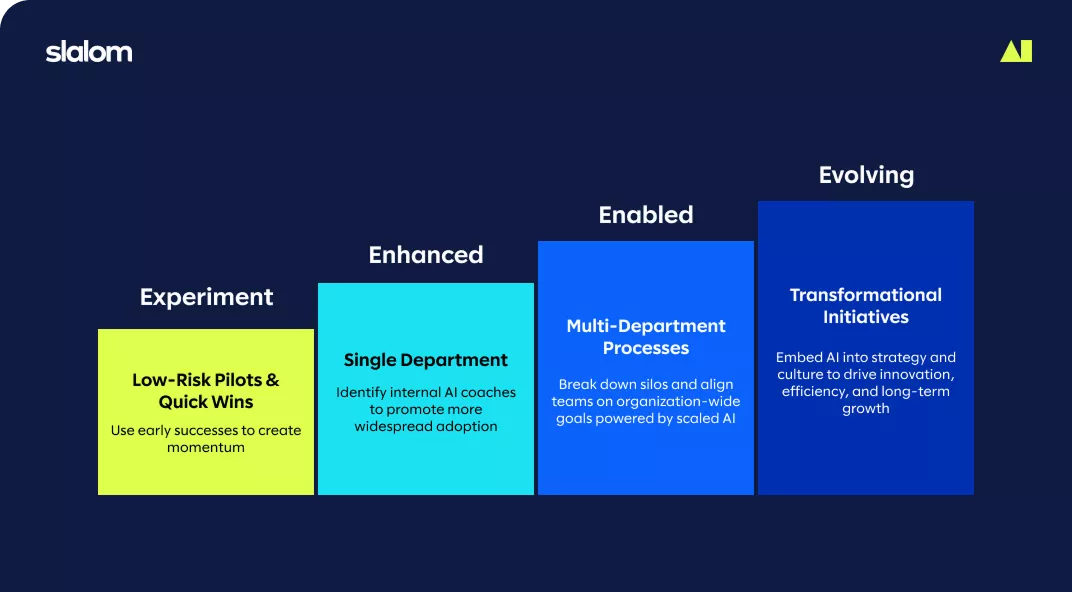It’s not the tech; it’s your people

Pivot toward your people to foster a resilient, AI-powered future
Despite billions of dollars invested in AI tools and infrastructure, many organizations still aren’t seeing meaningful returns. Why? Because the human systems haven’t caught up. According to recent research, employers expect to restructure nearly half their workforce by 2030 due to AI and automation. Meanwhile, demand for key skills—like AI fluency, big data, and cybersecurity—is expected to rise by over 60%.
Yet most companies are still treating AI adoption as a technical project, not a human transformation. So it’s no wonder that many employees feel unsure, unsupported, or even afraid of what AI means for their future. The result? A powerful new set of tools sitting idle while leaders wonder why they aren’t getting the outcomes they expected.
In her 2025 Trends—Artificial Intelligence report, Mary Meeker notes that ChatGPT reached 800 million global users in just 17 months, with 90% of adoption occurring outside North America. AI is no longer in test mode—it’s being used by the world, at scale, right now. And yet, even as organizations race to invest—$200 billion in capital expenditures by top US tech firms in 2024 alone—many are finding themselves stuck. Not because the tools are broken, but because the people using them aren’t fully empowered, aligned, or engaged.
Training on AI tools is an important first step for getting your people up and running and realizing some productivity gains. If you’re already doing this but find AI just isn’t sticking with your teams, it’s time to figure out why, because productivity is just the beginning. By disrupting traditional processes and structures and using AI to remove the barriers that keep humans from doing more value-added work, you can begin to move toward a more transformational phase of your AI journey and truly understand what all the AI hype is about.

Charting your future with AI
At Slalom, we’ve been helping clients modernize and transform for years, including navigating AI challenges. But we see this moment and AI adoption as something very different—it’s a new opportunity, not to simply “transform," as in the case of previous technology-led transformations, but to become adaptive. Adaptive organizations are led by future-focused leaders who make continuous learning and skilling top priorities. They don’t just respond; they anticipate and continuously prepare for disruption. Leaders of adaptive orgs therefore need to ensure they’re providing ample support for their people to become proficient with AI tools while also cultivating an environment where everyone is aware of and on board with expectations around AI.
Defining what your future with AI looks like, making sure all your leaders are aligned on your vision, and promoting that vision within their teams is important. But just as important is determining how your people are using AI now, as this could help you get to the bottom of why AI isn’t sticking. Many of your people are probably already using AI, but some may be reluctant to share their successes. If they demonstrate that AI is saving them time/effort/costs, some may fear this could result in budgets or resources being cut. At the same time, those who aren’t using AI may be equally fearful of the perception that they’re resistant to change or lacking in skills.
Every organization will have its own unique vision for the future—and its own unique path to get there. The following actions can guide you to greater success with AI no matter which path you take.
- Make learning an imperative
While some workers are afraid to admit a lack of knowledge, others over- or underestimate their abilities, all of which can make it difficult for leadership to determine what type and amount of training and encouragement are necessary for staff tackling a new technology like AI.
The key here is to create an environment where everyone is actively engaged in learning, no matter their existing skill/knowledge level. As quickly as AI technologies are evolving, learning has to be habitual and lasting, not merely a one-and-done exercise. With this continuous learning approach, you’ll be better able to see where your people’s strengths and skills lie and make adjustments to their roles to close any gaps and encourage your teams to pursue more value-adding uses of AI.
Research cited in Meeker’s report underscores this imperative: AI-adjacent roles now demand 37% higher cognitive skill levels and a 5% increase in social and collaborative skill use. Employers aren’t just looking for prompt engineering—they’re looking for adaptability, emotional intelligence, and complex problem-solving. Traditional training doesn’t always meet this moment. That’s why organizations must embrace continuous, community-based learning and invest in closing the real (not perceived) skills gaps.
Offering a variety of options for learning can increase the chances that your people will find a method that works best for them. Some will respond well to self-service, self-paced training modules, but group learning activities could prove more engaging by allowing for experience sharing, rather than simply working as individuals on a course curriculum. Gamification, community-based learning, hackathons, and cohort-based learning are more nontraditional learning approaches that can work very well for teams needing to upskill on AI. At Slalom, we help clients and consultants (and leaders in both) build AI literacy through "AI Bingo Challenge" cohorts that integrate learning into everyday work and help build confidence with tools in a safe, collaborative environment.
It may also be beneficial to create an AI learning lead role to help determine the best way to structure and incentivize your organization’s learning program, such as by recognizing those who take courses and participate in team-based learning and hackathons, making such activities part of employees’ development plans, and aligning incentives to learning objectives.
2. Bring leaders into alignment
Functional leaders and their teams may be hesitant to share the full extent of productivity gains achieved through AI due to concerns about potential budget or head-count cuts. The fear is that increased productivity, especially through automation, could be interpreted as a sign that fewer resources are needed to achieve the same or better output, rather than an indication that efficiency and intelligence are delivering the desired outcomes.
This fear only serves to stifle momentum. Instead, incentives should be aligned so that leaders who are able to demonstrate productivity and incremental value are rewarded. When wins are recognized and celebrated throughout the organization, leaders can more easily foster a culture of adaptability, transparency, experimentation, and alignment, where people are encouraged to share their successes and failures and learn from both.
In today’s AI economy, Meeker notes that organizations that attract top developer talent often win. And it’s not just about the coders—it’s about creating environments where innovators, analysts, and frontline users can all contribute to AI transformation.
3. Put a different lens on the future of work
Productivity gains are only the beginning when it comes to what AI can deliver when teams are encouraged to innovate in truly disruptive ways. Leaders can reinvent how their people work differently. Changing the conversation around what’s possible can inspire people to see opportunities to reallocate time, to rethink and chart new courses. As cited earlier, AI and automation will reshape work dramatically over the next five years, with nearly half of global employers expected to restructure their workforce. But rather than eliminating jobs, organizations will be looking to reimagine them, which will bring about a shift in demand. Satisfying that demand will take more than just reskilling; it will require a complete rethinking of how value is created.
Take for example a business that uses call center agents to field customer inquiries and complaints. Many organizations use AI in call centers with the intention of fielding more customer inquiries without having to hire more human agents. This satisfies the "productivity gain" end of the AI outcome spectrum. But what if these organizations were to use those AI gains to free up their teams for more thoughtful work? Instead of just responding to immediate pressures, agents could spend more time coming up with ways to increase connection and engagement to make the customer experience more positive and promote loyalty. This could strengthen brand reputation, which brings its own set of potential benefits, such as competitive advantage, the ability to attract higher-quality talent, and higher revenues.
AI adoption within resilient organizations is not just about workforce transformation. It’s also about anticipating continuous uncertainty, adapting to what comes next, and evolving organizational DNA to not only be responsive to changes like AI but to build the muscle for looking ahead. Real resilience means making sure there’s a different lens on the future of work and business as we evolve. This ability to anticipate and therefore act faster and more effectively needs to be fostered at every level, and every level needs to be willing to participate and invest the effort to become an adaptive organization.
Conclusion
The true potential of AI isn’t in the tools—it’s in your people’s willingness to use them with confidence, creativity, and clarity. When you invest in curiosity, normalize continuous learning, and reward experimentation, you don’t just make AI adoption stick—you lay the foundation for a future where human ingenuity thrives alongside intelligent machines.
In the race to AI maturity, your people aren’t just a risk to manage—they’re your greatest strategic asset. Are you investing in them like they are?





